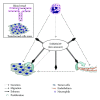Low concentration of S100A8/9 promotes angiogenesis-related activity of vascular endothelial cells: bridges among inflammation, angiogenesis, and tumorigenesis?
- PMID: 22685372
- PMCID: PMC3363068
- DOI: 10.1155/2012/248574
Low concentration of S100A8/9 promotes angiogenesis-related activity of vascular endothelial cells: bridges among inflammation, angiogenesis, and tumorigenesis?
Abstract
Previous studies showed that several members of the S100A family are involved in neovascularization and tumor development. This study checked whether low concentrations of S100A8 or S100A9 has any effect on the behaviour of vascular endothelial cells. A human umbilical vascular endothelial cell (HUVEC) line was used to measure vascular endothelial cell bioactivity related to angiogenesis, such as cell proliferation, migration, and vessel formation. In the low concentration range up to 10 μg/mL, either each alone or in combination, S100A8 and S100A9 proteins promoted proliferation of HUVEC cells in a dose-dependent manner. The presence of both proteins in culture showed additive effects over each single protein. Both proteins enhanced HUVEC cells to migrate across the transwell membrane and to form tube-like structures on the Matrigel surface. When mixed in Matrigel and injected subcutaneously in Balb/c mice, both proteins increased vessel development in the gel plugs. Microarray assay of HUVEC cells treated with 10 μg/mL S100A8 revealed that ribosome pathway, pathogenic Escherichia coli infection pathway, apoptosis, and stress response genes were modulated by S100A8 treatment. We propose that S100A8 and S100A9 proteins from either infiltrating inflammatory cells or tumor cells play an important role in the interplay among inflammation, angiogenesis, and tumorigenesis.
Figures





Similar articles
-
S100A8 and S100A9 promote endothelial cell activation through the RAGE‑mediated mammalian target of rapamycin complex 2 pathway.Mol Med Rep. 2020 Dec;22(6):5293-5303. doi: 10.3892/mmr.2020.11595. Epub 2020 Oct 14. Mol Med Rep. 2020. PMID: 33174028 Free PMC article.
-
Functional characterization of S100A8 and S100A9 in altering monolayer permeability of human umbilical endothelial cells.PLoS One. 2014 Mar 3;9(3):e90472. doi: 10.1371/journal.pone.0090472. eCollection 2014. PLoS One. 2014. PMID: 24595267 Free PMC article.
-
Investigating the extremes of the continuum of paracrine functions in CD34-/CD31+ CACs across diverse populations.Am J Physiol Heart Circ Physiol. 2017 Jan 1;312(1):H162-H172. doi: 10.1152/ajpheart.00342.2016. Epub 2016 Oct 28. Am J Physiol Heart Circ Physiol. 2017. PMID: 27793853 Free PMC article.
-
S100A8 and S100A9 in inflammation and cancer.Biochem Pharmacol. 2006 Nov 30;72(11):1622-31. doi: 10.1016/j.bcp.2006.05.017. Epub 2006 Jul 17. Biochem Pharmacol. 2006. PMID: 16846592 Review.
-
Inflammation-associated S100 proteins: new mechanisms that regulate function.Amino Acids. 2011 Oct;41(4):821-42. doi: 10.1007/s00726-010-0528-0. Epub 2010 Mar 6. Amino Acids. 2011. PMID: 20213444 Review.
Cited by
-
Clinical Value of Serum S100A8/A9 and CA15-3 in the Diagnosis of Breast Cancer.Iran J Pathol. 2019 Spring;14(2):104-112. doi: 10.30699/IJP.14.2.104. Epub 2019 Jun 10. Iran J Pathol. 2019. PMID: 31528166 Free PMC article.
-
Serum of Post-COVID-19 Syndrome Patients with or without ME/CFS Differentially Affects Endothelial Cell Function In Vitro.Cells. 2022 Aug 2;11(15):2376. doi: 10.3390/cells11152376. Cells. 2022. PMID: 35954219 Free PMC article.
-
Tasquinimod efficacy and S100A9 expression in glucose-treated HREC cells.Int Ophthalmol. 2022 Feb;42(2):661-676. doi: 10.1007/s10792-021-02038-y. Epub 2021 Nov 18. Int Ophthalmol. 2022. PMID: 34796432
-
S100A8 and S100A9 promote endothelial cell activation through the RAGE‑mediated mammalian target of rapamycin complex 2 pathway.Mol Med Rep. 2020 Dec;22(6):5293-5303. doi: 10.3892/mmr.2020.11595. Epub 2020 Oct 14. Mol Med Rep. 2020. PMID: 33174028 Free PMC article.
-
Potential serum biomarkers for glioblastoma diagnostic assessed by proteomic approaches.Proteome Sci. 2014 Sep 24;12(1):47. doi: 10.1186/s12953-014-0047-0. eCollection 2014. Proteome Sci. 2014. PMID: 25298751 Free PMC article.
References
-
- Kyewski B, Romero P. Chronic inflammation is regarded as a strong promoter of tumorigenesis. International Journal of Cancer. 2010;127(4, article 747) - PubMed
-
- Mumm JB, Oft M. Cytokine-based transformation of immune surveillance into tumor-promoting inflammation. Oncogene. 2008;27(45):5913–5919. - PubMed
-
- Kuper H, Adami HO, Trichopoulos D. Infections as a major preventable cause of human cancer. Journal of Internal Medicine. 2000;248(3):171–183. - PubMed
-
- Robinson SC, Coussens LM. Soluble mediators of inflammation during tumor development. Advances in Cancer Research. 2005;93:159–187. - PubMed
Publication types
MeSH terms
Substances
LinkOut - more resources
Full Text Sources
Molecular Biology Databases
Miscellaneous

